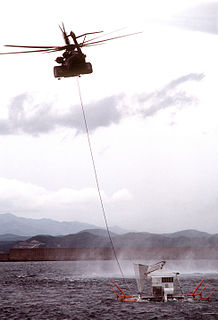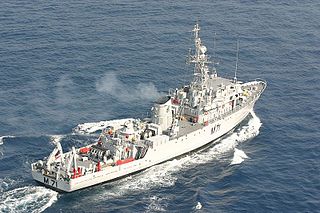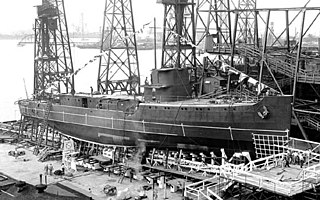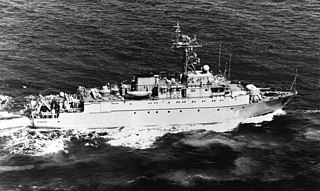
Minesweeping is the practice of the removal of explosive naval mines, usually by a specially designed ship called a minesweeper using various measures to either capture or detonate the mines, but sometimes also with an aircraft made for that purpose. Minesweeping has been practiced since the advent of naval mining in 1855 in the Crimean War. The first minesweepers date to that war and consisted of British rowboats trailing grapnels to snag the mines.

The Aggressive-class minesweepers are a class of US-built minesweepers. They are designated as MSO, distinguishing them from the smaller coastal MSCs and inshore MSIs. Besides the US Navy, this class of vessels has also been used by the Belgian Navy and the Norwegian Navy, among others.

The Pondicherry class are a class of minesweepers built for the Indian Navy by the Soviet Union. They are modified versions of the Natya-class minesweeper. The vessels were acquired in two batches. The first were purchased from 1978 to 1980 and the second from 1986 to 1988. Technically, the second batch is referred to as the Karwar class but are physically identical to the first batch with the exception of additional surface-to-air missiles. As minesweepers, they are large and heavily armed. They can serve a dual purpose as an anti-submarine warfare escort. Their hulls are constructed of U3 low magnetic signature steel.
HMS Altham was one of 93 ships of the Ham class of inshore minesweepers.
HMS Asheldham was one of 93 ships of the Ham class of inshore minesweepers.

USS Auk (AM-57) was an Auk-class minesweeper acquired by the United States Navy for the dangerous task of removing mines from minefields laid in the water to prevent ships from passing.
HMS Packington was a Ton-class minesweeper built by Harland & Wolff for the Royal Navy. The following year she was transferred to the South African Navy and renamed SAS Walvisbaai. The ship was decommissioned in March 2001 and was sold to the Walt Disney Company in 2003 to be used in the Wes Anderson film The Life Aquatic with Steve Zissou.

The Auk class were Allied minesweepers serving with the United States Navy and the British Royal Navy during the Second World War. In total, there were 95 Auks built.

USS Shoveler (AM-382) was an Auk-class minesweeper acquired by the U.S. Navy for the dangerous task of removing mines from minefields laid in the water to prevent ships from passing.
The second USS Swan was laid down on 12 August 1943 by the Gibbs Gas Engine Co., at Jacksonville, Florida, as Patrol Craft, Sweeper, PCS-1438; and was redesignated Auxiliary Motor Minesweeper YMS-470, on 27 September 1943. Launched on 5 April 1944; the ship was completed and commissioned on 14 October 1944.
USS Success (AM-310) was an Admirable-class minesweeper built for the United States Navy during World War II. She was awarded four battle stars for service in the Pacific during World War II. She was decommissioned in July 1946 and placed in reserve. While she remained in reserve, Success was reclassified as MSF-310 in February 1955 but never reactivated. In October 1962, she was sold to the Mexican Navy and renamed ARM DM-08. Although she is reported out of service, her ultimate fate is not reported in secondary sources.

USS Notable (AM-267) was an Admirable-class minesweeper built for the United States Navy during World War II. She earned two battle stars in service in the Atlantic and the Pacific during the war. In 1946, she was decommissioned and turned over to the Republic of China for service with the Chinese Maritime Customs Service. Her ultimate fate is unreported in secondary sources.

USS Shrike (AMS/MSC-201) was an Bluebird-class minesweeper acquired by the US Navy for clearing coastal minefields.

USS Notable (AM-460/MSO-460) was an Aggressive-class minesweeper acquired by the U.S. Navy for the task of removing mines that had been placed in the water to prevent the safe passage of ships.

The Royal Naval Patrol Service (RNPS) was a branch of the Royal Navy active during both the First and Second World Wars. The RNPS operated many small auxiliary vessels such as naval trawlers for anti-submarine and minesweeping operations to protect coastal Britain and convoys.

A naval trawler is a vessel built along the lines of a fishing trawler but fitted out for naval purposes. Naval trawlers were widely used during the First and Second World Wars. Fishing trawlers were particularly suited for many naval requirements because they were robust boats designed to work heavy trawls in all types of weather and had large clear working decks. One could create a mine sweeper simply by replacing the trawl with a mine sweep. Adding depth charge racks on the deck, ASDIC below, and a 3-inch (76 mm) or 4-inch (102 mm) gun in the bow equipped the trawler for anti-submarine duties.
"The Sweepers" is a poem written by Rudyard Kipling (1865-1936), and set to music by the English composer Edward Elgar in 1917, as the fourth of a set of four war-related songs on nautical subjects for which he chose the title "The Fringes of the Fleet".

The Gorya class are a group of minesweepers built for the Soviet Navy in the late 1980s. Three ships were started of which two were completed and are in service with the Russian Navy. The Soviet Designation was Project 12660.
This page is based on this
Wikipedia article Text is available under the
CC BY-SA 4.0 license; additional terms may apply.
Images, videos and audio are available under their respective licenses.














